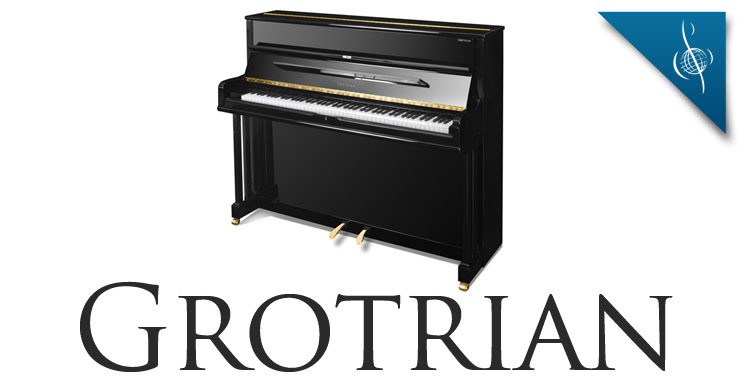Grotrian Pianos
Grotrian pianos are far more legendary than their numbers would suggest – for a company that produces just 500 – 1000 pianos annually, they have been the subject of a New York Times Bestseller novel, consistently in the Top 5 or Top 10 of every official and unofficial ranking magazine out there, trains and certifies the majority of master piano builders in Europe, and carries with it one of the richest and most storied histories of any piano company on earth.
Their upright pianos in particular are the stuff of legend, with the Concertino model being regarded by many as the finest upright in the world. Their Compose Exclusif, a limited edition of just 50 instruments, also won very high praise for it’s unusually long sustain and bell-like treble. The grand model “Cabinet” is also regarded by many as one of the more unique and treasured instruments on the market – the model which became the subject of the novel “Grand Obsession” in the mid 2000’s.
The company is still entirely private, and their pianos are still completely built in Germany by hand. They are currently in their 178th year.
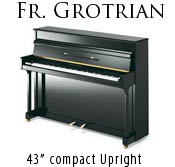
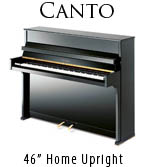

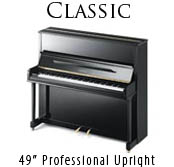
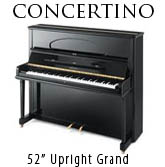
The Notable Differences
Grotrians most defining characteristic is it’s tone. A Grotrian treble is absolutely unmistakable, and there’s a very good reason for that: the octagonal strings gives it a highly specific overtone profile. According to the company, 8-sided string emphasises the fundamental and 4th partial, which happens to be very similar to silver church bells. As one plays a Grotrian, the choir comparison comes easily…the blending of the harmonics is hauntingly beautiful, and is arguably unique to Grotrian.
This feature is found on both their grands and uprights, but certainly the vertical models bring this characteristic out even more so, since the player is so much closer to the strings and the point of the hammers’ impact.
Grotrian pianos (with the exception of the Fredrich Grotrian) use star-shaped back posts. This very expensive and more difficult method of construction gives the pianos a rigidity that few instruments can match. Several instruments and manufacturers have tried to use the star-shaped backs in the past, but Grotrian is the only company to have consistently stuck with them in all sizes, and (more impressively) all economies.
On typical upright pianos, the back of the piano, and generally the overall structure, is supported by a number of vertical posts called back posts. These can be made of solid maple, beech, and in some cases spruce might be used. Although the overall stability of an instrument is achieved through the combination of a number of factors, backpost construction is generally a good indication of the overall strength of a piano, and its overall tuning and tonal stability.
There is a story out of Grotrian that has become something of a legend within piano circles; there is someone at the factory whose only job it is to drop unfitted hammer shanks onto a ceramic tile and….listen to them. Grotrian is known for their fanaticism with precision and accuracy, but this simply takes it to a whole other level. What, you might wonder, is this gentleman listing for? Each shank, when dropped, produces a fundamental pitch, which is then matched to the tone of the string that it will eventually, along with the hammer, strike and produce the piano’s sound. The theory behind this extraordinarily fussy process is that an incompatible shank might cause interference waves at the point of the hammer strike, which might in turn cause false beating or competing frequencies.
It may only be 0.1% of the factors behind each Grotrian’s superb playing experience, but in the world of high-performance pianos, sometimes 0.1% counts.
Grotrian does something outside of piano making that no other builder engages in: they run a living, breathing, accredited piano university. On top of their main product (their pianos), their next largest export are certified Master Piano Builders, a graduate-level designation recognized by the German government. And the reason that Grotrian is so well suited for this type of training lies in the very nature of their production process: they operate on a multi-generational team / station structure that allows several levels of staff to work alongside one another seamlessly.
Essentially, each piano must move from station to station, as a different stage of the pianos construction is completed. These stages might be “stringing”, or “pinning”, or “regulation / voicing”, or strung-back installation. As each piano comes to a new station, a team of workers begins to carry out the corresponding task. That team is always made up of a senior master builder, a mid-level master builder, and a trainee. So throughout the piano’s construction it is constantly being worked on by the very best, while allowing prospective graduates the opportunity to participate in every level as well. Each instrument does NOT leave the station until that master piano builder has signed off – there is absolutely no time limit.
Grotrian has been able, therefore, to have generation after generation of the best trained, intensely loyal staff, allowing them to slowly and methodically build a 175+ year reputation for consistency and perfection.

